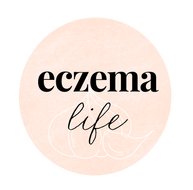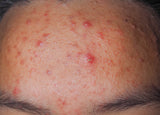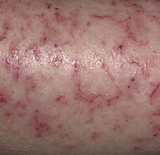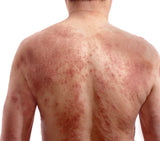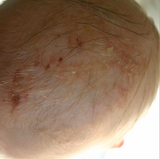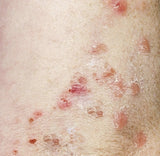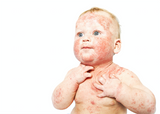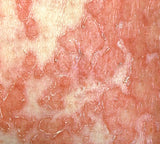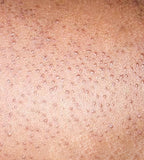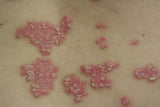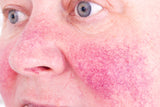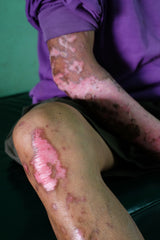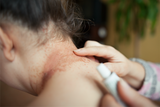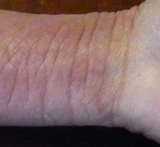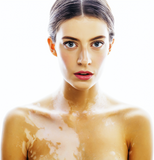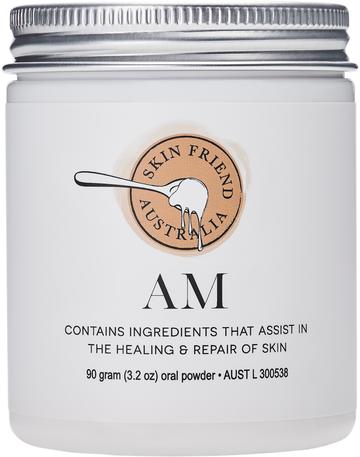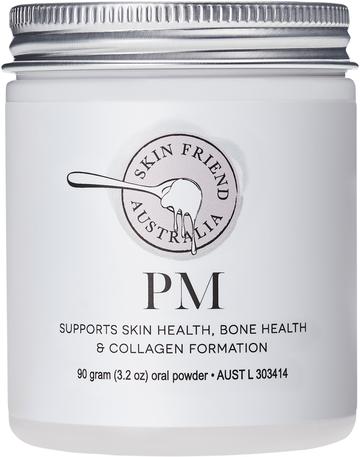Skin Disorders, Causes & Treatments
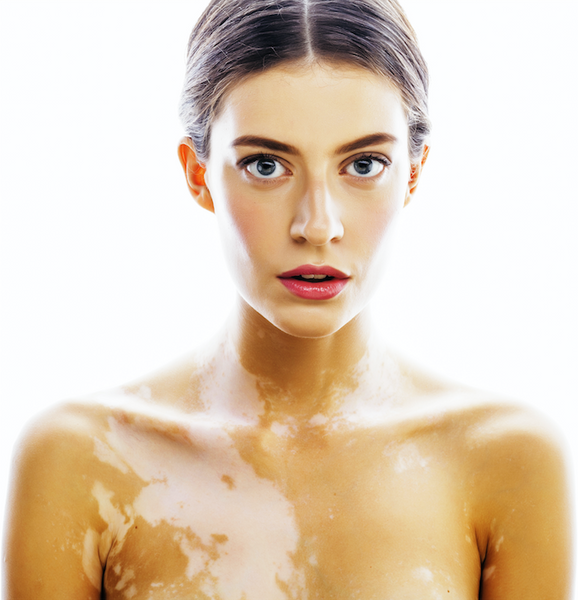
Using the table below, look up your skin disorder and find the best treatments for your condition. Skin disorders are shown in alphabetical order. Click on the photos to enlarge them.
For skin disorder 'before and after' photos see our testimonials page.
|
SKIN DISORDER |
CAUSES |
TREATMENTS |
|
Hair follicles become blocked with oil and dead skin cells. Acne is commonly triggered by hormones, dairy consumption, poor diet: i.e. too much sugar, saturated fats and omega-6 in the diet (such as almonds and cooking oils). |
Avoid trigger foods including fatty meats (trim fat of meats), dairy products, almonds (omega-6), almond milk, cocoa, cacao, chocolate, vegetable oils, rice bran oil (omega-6), coconut oil (saturated fat) --(only use extra virgin olive oil). Supplement with vitamin A and vitamin B5 as they dry out oily skin (caution: both in high doses can cause skin flaking). Skin Friend AM. |
|
|
Ageing (usually occurs over age 60), nutritional deficiencies, topical steroid use (the skin disorder appears when topical steroids are discontinued), also worsened by soaps and detergents. |
Check for nutritional deficiencies and food chemical intolerances (see the FID Program from The Eczema Detox). Increase low-fat protein intake (lean meats and/or plain unflavoured pea protein powder); Skin Friend AM; avoid harsh soaps and detergents. Avoid vitamin A supplements as they worsen skin flaking. |
|
|
Can be triggered by acid-forming diet, poor diet, too much sugar, poor digestion, stress, sensitivity to chemicals (salicylates, sulfites, amines and/or glutamates /MSG), environmental allergies, and/or low calcium levels in the skin. |
Food Intolerance Diagnosis Program from The Eczema Detox; allergy testing; supplement with omega-3 from algae or 1/2 teaspoon of flaxseed oil daily; calcium carbonate to reduce acidity in the body and replenish skin calcium levels (Skin Friend PM); magnesium, biotin, vitamins B1, B2, B3, (low dose B vitamins), plus zinc, vitamin C and B6 as they are natural anti-histamines; plus molybdenum to prevent sulfite sensitivity (Skin Friend AM). Avoid vitamin A (retinol forms). |
|
|
Direct contact with irritants, stress, latex, nickel and/or cheap jewellery; sensitivity to soaps, essential oils and detergents; nutritional deficiencies; stress; work hazards such as hairdressing chemicals etc. |
Reduce stress and increase rest; avoid contact irritants as much as possible; supplement with molybdenum, magnesium, zinc, B vitamins, omega-3 and calcium. Contraindicated: Avoid vitamin A (retinol forms; beta- carotene is fine) and avoid high dose vitamin B5 (under 10mg is fine or RDI) as they worsen dry skin flaking. |
|
|
Triggers include malabsorption of fats and under functioning liver, which is totally normal for children under age 2-- when they turn two their liver function usually kicks in properly and skin problems are less likely to occur. |
Gentle shampoo to wash scalp, use plain apricot oil or jojoba oil and a fine-toothed comb to gently comb the crusts off. Low chemical diet that is gentle on their developing liver (The Eczema Detox). |
|
| Triggers include chemical sensitivity (such as intolerance to salicylates, sulfites, amines, MSG perfumes and/or dyes etc.); candida albicans, leaky gut; stress and/or dust mite sensitivity. |
Eat quality protein in the diet (trim fat off meats), reduce stress. Reduce chemical sensitivities with liver detox nutrients (Skin Friend AM), test for vitamin D deficiency. AVOID vitamin A (retinol forms; beta-carotene is fine) and avoid high vitamin B5 as they cause dry skin flaking. |
|
Triggers often include gluten intolerance or coeliac disease |
Avoid gluten, then test for gluten intolerance a month later by consuming it in the diet. If an adverse reaction occurs, avoid gluten. Probiotics. |
|
|
Triggers include allergies, fungal infection, stress, pollen sensitivity, excess contact with moisture, nickel or cobalt allergy or chemical sensitivities. |
Use the Food Intolerance Diagnosis Program (The Eczema Detox) to diagnose food and/or chemical intolerances i.e. salicylate, MSG, amine and sulphite sensitivity. Supplement with low dose B vitamins, biotin, magnesium, zinc (Skin Friend AM), and omega-3 from algae oil, fish oil or organic flaxseed oil.
|
|
|
Caused by ageing, and/or filaggrin gene defect (which causes very dry skin); poor absorption of nutrients, and possibly low protein or excess saturated fats in the diet. |
Eat quality protein in the diet (trim fat off meats or use a mixture of pea protein and rice protein), exercise, reduce stress. Take omega-3 (1/2 teaspoon flaxseed oil). Correct nutritional deficiencies and strengthen the skin. AVOID vitamin A supplements (retinol forms; beta-carotene is fine) and avoid high vitamin B5 as they can cause severe dry skin flaking. |
|
|
(atopic means allergies) Babies: genetics and under functioning liver – results in difficulty detoxifying chemicals (normal for under age 2, and the liver kicks in and functions better around age 2) (Beath 2003) Other: nutritional deficiencies, poor detoxification of chemicals, allergies,liver dysfunction, leaky gut, chemical sensitivities, stress, environmental. Eczema people tends to have increased acid in the body; and 34% of children with eczema have fatty liver (Kimata 2005). |
Identify nutritional deficiencies and use the FID Program to diagnose if chemical intolerances are involved The Eczema Detox), recommend allergy testing. Supplement with EPA (omega-3 from algae, or flaxseed oil); calcium carbonate to reduce acidity in the body (Skin Friend PM); magnesium, molybdenum, biotin, vitamins B1, B2, B3, B6 (low dose B vitamins as high Bs can increase skin itching), zinc and vitamin C (Skin Friend AM). Avoid vitamin A (retinol forms). For before and after photos see our testimonials page. |
|
|
Often triggered by topical steroid overuse or wet wraps with steroid creams, then exposure to infection (i.e. herpes virus). Topical steroid use weakens the skin barrier function. |
Zinc and high dose lysine help to prevent herpes breakouts, plus check for nutritional deficiencies; 1/2 teaspoon of flaxseed oil daily, antiviral medications may be prescribed by your doctor; nutritional support is important. See ‘Eczema’, above for more tips. |
|
|
Can be caused by metabolic syndrome, obesity, hormones or “lifestyles comforted by smoking, drinking alcohol and ingesting chemicals or drugs” (i.e. the person may be medicating stress and trauma by ingesting toxins). |
Quit smoking program (for smokers), management of stress, self-nurturing and lifestyle changes are often required. Avoid chemicals such as deodorants, soft drinks, smoking, fast foods etc. If you have problems breaking habits, see a therapist or hypnotherapist who specialises in habit breaking (see link for a good Sydney Hypnotherapist). Low chemical detox or FID Program from The Eczema Detox to identify your triggers and avoid them: Triggers may include sugar, caffeine, dairy, alcohol, nightshades (tobacco, cayenne, paprika, tomato, eggplant, potatoes, peppers, capsicum, tomatillos and goji berries/ wolfberries). Supplement with zinc, vitamin C, vitamin E, biotin, B6, B3 (AM), magnesium, calcium (PM) and quality non- dairy protein powder (no flavourings). |
|
|
Genetic, possibly from nutritional deficiencies and chemical sensitivity. |
Omega-3 to hydrate the skin (flaxseed oil taken internally), zinc, calcium, check for chemical sensitivities and deficiencies (FID Program). |
|
SKIN DISORDER |
CAUSES |
TREATMENTS |
|
Vitamin A and EFA (omega-3) deficiencies are common triggers. |
||
|
Healthy skin cells turn over every ~28 days but with psoriasis skin cells turn over every 3-4 days (the body is trying to eliminate toxins through the skin!). Commonly seen in smokers, and can be triggered by stress and high chemical exposures such as nicotine, pesticides, salicylates and perfumes. |
Low chemical detox program (The Eczema Detox) or FID Program to diagnose chemical intolerances (check tannins, salicylates, amines, nightshades etc). Check for nutrient deficiencies. Take liver detoxification nutrients including low dose B vitamins, biotin, zinc, calcium, vitamin C, molybdenum (Skin Friend AM). Don’t place an extra burden on the liver: avoid irritants such as smoking, alcohol and limit stress (if severe psoriasis, a change in lifestyle is often required). |
|
|
Triggered by amine sensitivity, histamines, sulphites in wines, sedentary lifestyle, poor blood supply to the skin (in rosacea the blood vessels widen to allow ‘sluggish’ blood quicker access to the skin). |
Avoid amines/histamines as they trigger flushing symptoms, check for salicylate and sulphite sensitivity -- take molybdenum. |
|
|
Greasy yellowish flakes and itching where oil (sebaceous) glands appear. May begin as dandruff. Pityrosporum ovale (a yeast, also known as malassezia furfur) is on the skin of people with seborrhoeic dermatitis; antibiotic use can trigger it. |
Check for nutritional deficiencies Try The Eczema Detox or use the FID Program to diagnose chemical intolerances. |
|
|
“Fibrous degeneration of connective tissue caused by excessive acidity in the body”. (Mosby’s Medical Dictionary, 10th edition, 2017) |
Use the FID Program from The Eczema Detox to diagnose food and chemical intolerances (also check for tannin intolerance). Avoid your trigger foods once diagnosed. Eat more alkalising foods (low chemical ones such as mung bean sprouts, beetroot) and take alkaline forms of calcium (Skin Friend PM) to restore acid-alkaline balance; zinc gluconate , low dose B vitamins - enough to prevent deficiencies (avoid high doses). Check for vitamin D and other deficiencies. |
|
|
Topical steroid overuse, usually over a period of years. Causes an influx of nitric oxide in the blood which causes the skin to appear red - this can cause vitamin B12 deficiency as B12 is needed for the body to process and remove nitric oxide. Mimics rosacea. |
Check for nutritional deficiencies (signs of deficiencies include hair loss, cracked corners of mouth, insomnia, cracked lips etc). Take vitamin B12 to reduce excess nitric oxide. Avoid/limit salicylates as they increase nitric oxide which worsens skin redness. Detox or FID Program to identify chemical intolerances. Topical steroids can cause fatty liver so check for fatty liver (ultrasound if indicated). If you have fatty liver or signs of nutrient deficiencies try Skin Friend AM, and 1/2 teaspoon of flaxseed oil daily. See ‘Eczema’ & ‘Rosacea’ for more advice. For before and after photos see our testimonials page. |
|
Can be caused by chemical sensitivity, specifically "tannin sensitivity" or tannin toxicity. Tannins are common in teas and coffee. Research: “high phenol/tannin content of the foods in India could explain why the world’s highest incidence of vitiligo is in India” (Namazi, 2009). Tannins chelate metal ions (causing mineral deficiencies) and the tannins elevate levels of interleukin-1α (IL-1α) as seen in vitiligo. |
Food Intolerance Diagnosis Program – plus low tannin diet – to diagnose if tannins and chemical intolerance are involved. Identify mineral/nutrient deficiencies; avoid tannin-rich foods such as teas, coffee, green tea, wine, beer, chocolate, cacao, carob, apples, pears, bananas, berries, rhubarb, spices, nuts, avocados, vanilla, dates, cinnamon, grapes, pomegranates, oranges etc. Liver support nutrients may be useful (may need to avoid herbal ingredients as they are rich in tannins). |
For before and after photos see our testimonials page.
© 2018 Karen Fischer in text and images I www.eczemalife.com
Products
At Eczema Life, we recommend nutritionist Karen Fischer's low food chemical program (The Eczema Detox) along with additive-free supplements for skin health and wellbeing. Click on the images to view more details:
